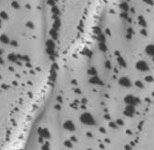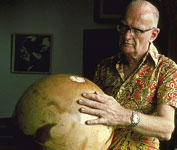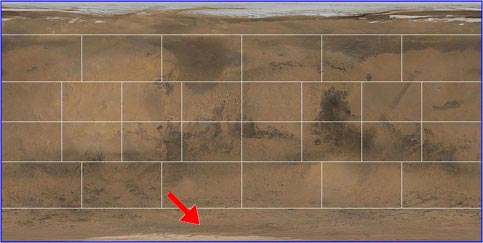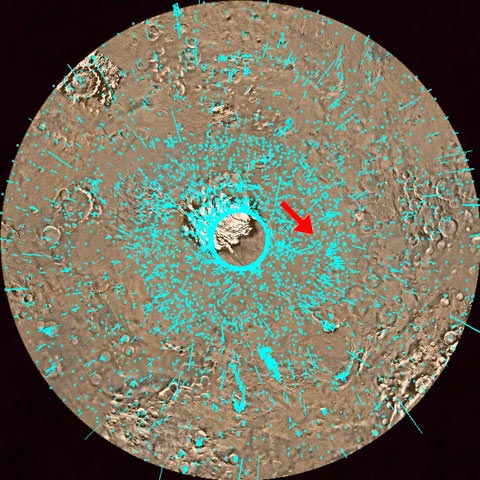| MARTIAN
TREES |
|
 |
|
Theories
How to find the images
More info
|
| |
| |
|
|
| THEORIES... |
| |
|
Interesting
and strange images from the Mars
Global Surveyor (MGS) appear to indicate plant life on the
planet. One image shows what appear to be tree-shaped structures
in the south polar region. Another image has dark spots that
look like shrubs in a desert. It turns out that these shapes
vary during the year, and change size and color depending on
the season. They get larger and darker during the summer as
would be expected by plants. This has led a Hungarian research
team (Institute
for Advanced Study, Budapest) to conclude that may be evidence
of living organisms.
ORTHODOX:
The official NASA
story is that the tree-like images are actually "sand
dunes topped with melting frost." Given that the temperature
on the surface is -150 C, they are not believed to be plants.
Also, according to an article
in SPACE.com, a NASA Mars Exploration Program Scientist
James Garvin did not feel that the evidence was "adequate
to draw definitive conclusions about whether biological processes
were involved in their origin". Other viewpoints include
"bizarre geology" and "frosting-defrosting"
processes. Regarding the "shrublike images," the Malin
Space Science Systems website claims
that they are also "defrosting sand dunes."
ALTERNATIVE: The Hungarian
team believes that the shrubby looking "dark dune spots"
may be plant-like organisms that are under a layer of ice in
the winter and emerge when the ice melts in the summer.
|
| Sir
Arthur C. Clarke, (image, right, courtesy of Popular
Science) has jumped into the fray in a June 2001 interview
noting that these images, which he thinks look like Banyan trees,
support his belief in life on Mars. The author of 2001 joked "I'm
now convinced that Mars is inhabited by a race of demented landscape
gardeners." |
 |
| JIMBO's
VIEW:
The tree picture appears to show that there is a shadow cast on
each "tree" by the sun, the shadow being roughly 300
meters, somewhat independent of the width of the object. Therefore,
they can not be simply spots of frost, although since the sun
is low in the sky (about 1 hour of true solar time according to
the data
of the tree image), it is possible that these objects are not
very tall. I don't like the Banyan tree theory, because some of
them would have to be 1.5 km wide, according to the resolution
of the image. I also find curious a tree that would look like
a crystal formation from above. The original NASA explanation
doesn't seem to fit either since many of the objects in the upper
part of the image are only 20 meters wide or so, and it doesn't
make much sense that a large number of dunes just happened to
only have a 20 meter top poking through after the frost melts.
So, I'm thinking some sort of weird patch of vegitation covered
in ice which melts in patterns radially outwards from the center.
As for the cold temps, some earthbound plants are known to be
very hardy. For example, redosier
dogwood stems can survive temperatures slightly colder than
300 degrees below zero. |
|
|
| |
| HOW
TO FIND the images from the original MGS charts... |
| |
1.
Go to the Malin Space Science Systems web site. Click on the images
link (or go directly
here.)
2. Click on the "MO7 through M12, September 1999 - February
2000" link (or go directly
here.)
3. You'll see a map like the one shown below in Figure
1. Click on the southern
pole MC-30: Mare Australe. See red arrow in Figure
1 for location of segment. |
| |
 Figure
1
Figure
1 |
| |
| 4.
You'll see a detailed map like the one shown below in Figure 2.
At about a third of the way from the south pole to the right edge
of the picture (82.02°S, 284.38°W), click on https://www.msss.com/moc_gallery/m07_m12/resolve/resolve_Mare_Australe_SP-162.html
(the mouseover will say ("click here to select footprints
in the area 82.0° to 81.0°S, 270.0° to 285.0°W."))
See red arrow in Figure 2 for location of link. |
| |
 Figure
2
Figure
2 |
| |
5.
Since there are close or overlapping links in this region, the
page that opens will give several options. Select Image ID M08-04688
(or click
here to go directly to it).
6. Select one of the "full-size image" links.
7. The trees are in the upper right part of the image. |
| |
| MORE
INFO ... |
| |
|
|
|